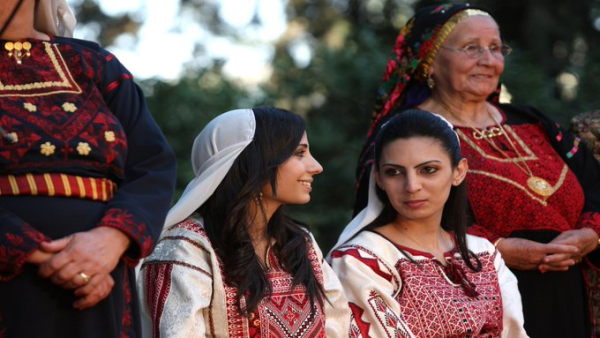UNESCO announced it will include the craft on the Representative List of the Intangible Cultural Heritage of Humanity.
The United Nations’ cultural agency (UNESCO) added the art of Palestinian embroidery, or tatreez in Arabic, to its Representative List of the Intangible Cultural Heritage of Humanity.
UNESCO yesterday added Palestinian Embroidery (Tatreez) to its Intangible Cultural Heritage of Humanity list. #FreePalestine pic.twitter.com/Drqin8L9Np
— V PALESTINE ?? (@V_Palestine20) December 16, 2021
Palestinians welcomed the listing, which was announced during the 16th session of the Intergovernmental Committee for the Safeguarding of the Intangible Cultural Heritage of Humanity, an annual gathering of governments, NGOs and cultural institutions.
The craft, which dates back more than 3,000 years, is a traditional form of cross-stitch embroidery originally made and worn in rural areas, known for its coloured threads and unique patterns. The colours used symbolise different stages of life, and different shades of the same colour denote regional differences.
Following attempts of Israeli appropriation, Palestinians welcome #UNESCO bringing traditional #Palestinian ?? embrodiery (Tatreez) under its protection as a 'victory'.. Further details below ? pic.twitter.com/tKYWtWljAT
— A21 Middle East News (@a21middleeastn1) December 16, 2021
Over time, the art has also taken on a meaning of resistance as it continues to play a key role in Palestinian cultural and even economic life.
Here’s how tatreez became a potent cultural symbol of ‘resistance,’ intertwined with Palestine’s political history.
Palestinian authorities have thanked UNESCO and commented that adding Tatreez to the list is a timely move, after accusations of cultural appropriation during the Miss Universe contest in Israel. https://t.co/XJpPtG2xtK
— Middle East Eye (@MiddleEastEye) December 18, 2021
After the Nakba: identity and displacement
After the Palestinian Nakba in 1948, when more than 700,000 people were expelled from their homes across historic Palestine, the art became a symbol of that displacement.
Congratulations ‼️
Palestinian embroidery; tatreez has been inscribed on UNESCO intangible cultural heritage
Meet the woman fusing the traditional Japanese Obi with the Palestinian tatreez https://t.co/x0vQ1MZYZi— 山本(荒川)真希?12/7-ラトビア日本100周年事業. 12/14いけばなインターナショナル (@maki_ya0521) December 16, 2021
Women wore their thobes (traditional embroidered dresses) or carried them on their backs as a statement of the very ‘existence’ of the villages they had been expelled from.
The ‘intifada dress’
During the first Intifada from 1987 to 1993, tatreez became an even more important symbol of defiance and what Palestinians would describe as “steadfastness”. As the Israeli authorities confiscated the Palestinian flags and other symbols, Palestinian women created what is known as the “Intifada dress”, embroidered with flags, maps of Palestine and other national symbols. The dress openly challenged the Israeli ban on public displays of Palestinian nationalism.
?? Another VICTORY ?? The minister of culture of UNESCO added Palestinian Embroidery (Tatreez) to its Intangible Cultural Heritage of Humanity list today after thieving 'israel' attempted to promote Tatreez as part of the 'israeli' culture (no such thing) during the Miss Universe pic.twitter.com/BCUhLIfOEV
— ????تونسية حرة (@jelassimarwa) December 16, 2021
Over the years, it also became an important source of income for the diaspora, particularly in Palestinian refugee camps in Lebanon, where Palestinians are barred from over seventy professions.
Appropriation and reappropriation
sorry not sorry but I’m going to post more photos of me in palestinian tatreez. colonisers wish they were us pic.twitter.com/toi2P0qAVC
— Jennine #SaveSheikhJarrah #SaveSilwan (@jennineak) December 14, 2021
Tatreez has been at the centre of controversies for the ways it has been appropriated or co-opted. Among others, critics say that international NGOs in Palestine have contributed to the commodification and simultaneous depoliticisation of the art. In 2017, a group of Palestinian Bedouin women from the Negev desert said they had been “deceived” by an Israeli fashion designer who had asked them to create an embroidered dress that went on to be used in a fundraiser for a group supporting Jewish settlement in the Negev.
Miss Universe tried to white wash this tatreez embroidery as “Israeli Bedouin dress”. Y’all don’t know every Palestinian region including those ethnically cleansed (urban, rural, and nomadic) all have their own styles. Shoutout to the women of Palestine ?? pic.twitter.com/Rav9jYuRvi
— Haithoom (@ADHaithD) December 10, 2021
The art still plays an important role in the Palestinian diaspora, as fashion designers and artists seek to keep the tradition alive, or reinvent it altogether.








